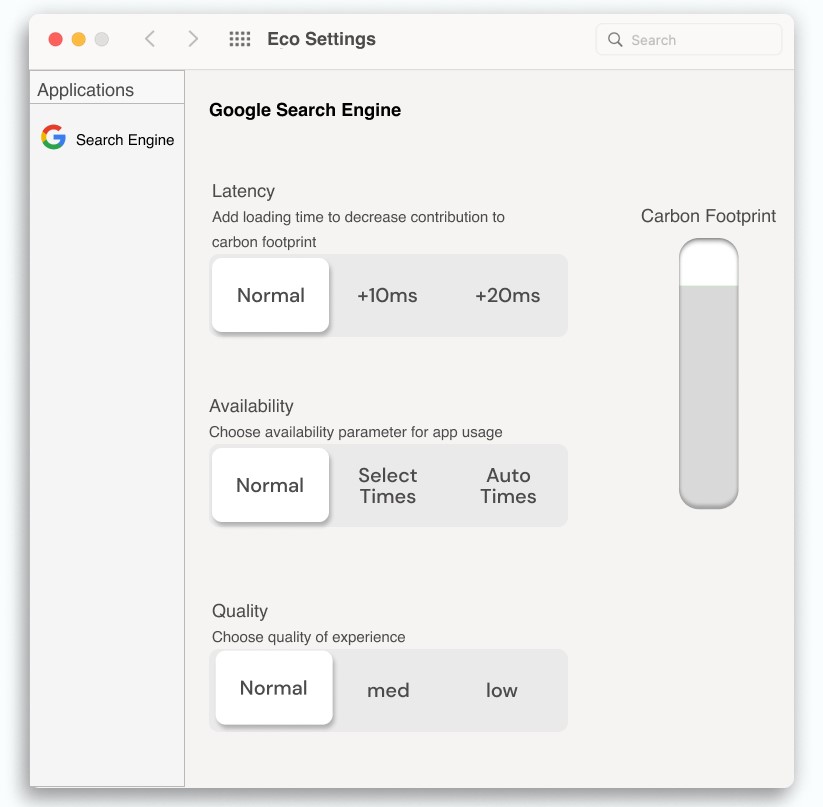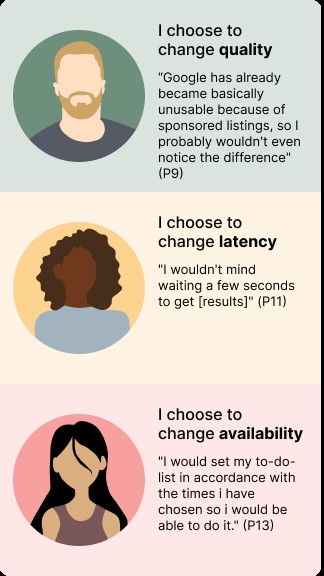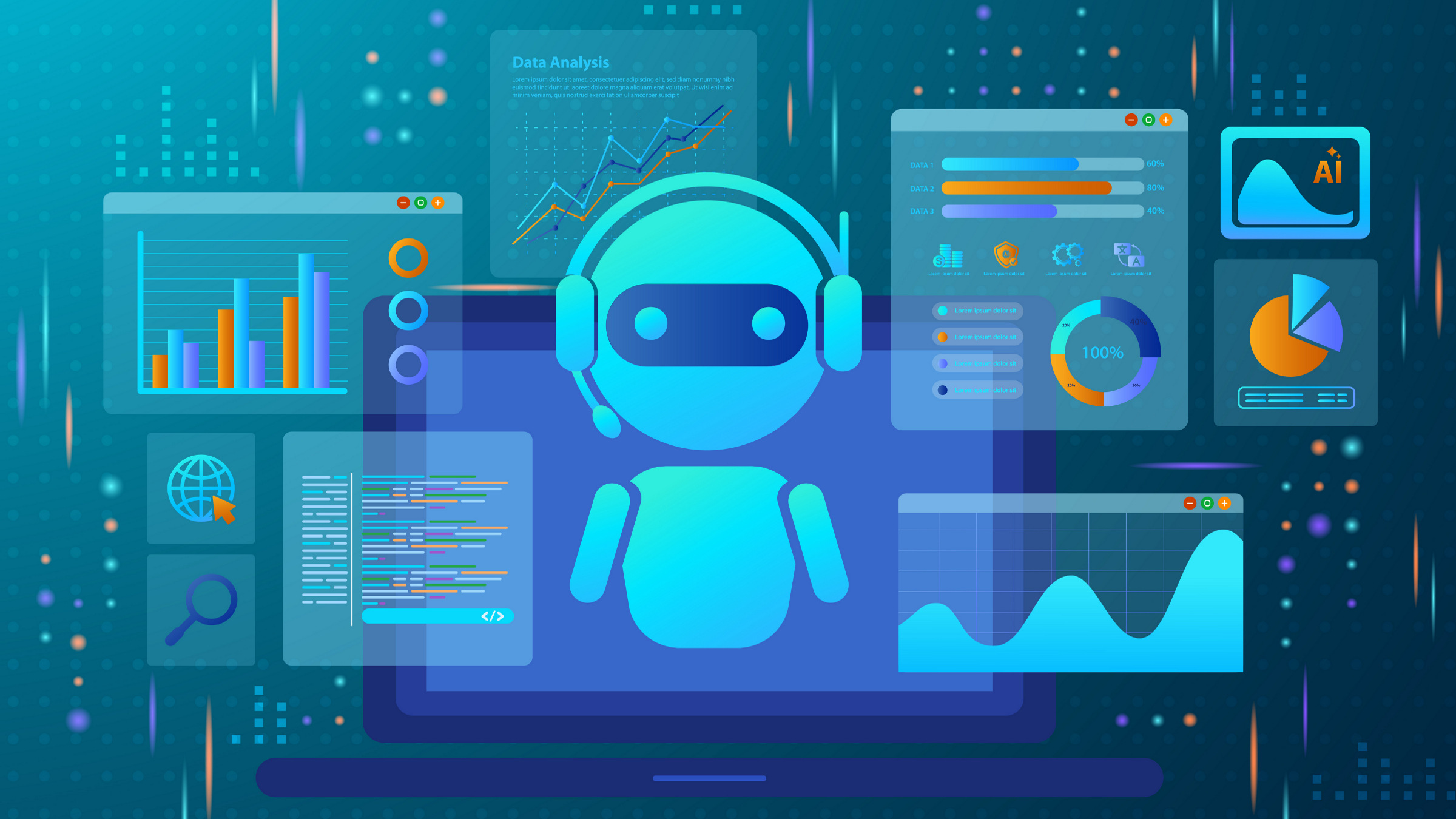Modern information and communication technologies (ICT) contribute to up to 3% of global carbon emissions. These emissions are growing as Internet use grows and new applications (such as large language models/LLMs) are deployed—increasing the user base and increasing per-user carbon cost. This growth in emissions has led to significant exploration in the computer systems community to understand and mitigate the environmental impact of computing services and platforms. In parallel, recent efforts in human-computer interaction focus on eco-feedback systems, persuasive technologies, and sustainable design practices. However, there is a significant gap between the two communities, computer systems and human-computer interaction, in terms of approach, focus, and goals. To effect meaningful change, holistic, cross-area efforts that address policy, systems, and users all at once are required. This article explores the shared, intersectional problem space of empowered users making carbon-aware decisions that guide computer systems operation.
Facilitating Sustainable User Choices
“Green consumerism,” is the idea that consumers’ decision to purchase or not to purchase an item is mediated at least partly by considering the item’s impact on environmental or social conditions.9 In response to a general upswell of awareness around sustainable development goals (SDGs) and climate change, large corporations such as Google and Amazon have provided users with tangible sustainable choices. For example, when checking out on Amazon, if a customer has more than one item in an order, they can opt into Amazon Day, which delays shipping until all items are available to be placed in the same shipping box. Additionally, Amazon allows users to filter a search to only show items containing a climate pledge certification. Similarly, Google’s search engine allows users to filter for low-emission options when searching for flights, as well as enabling users to search eco-certified hotels when booking travel plans. This article asks whether ICT can also change in response to user preferences about carbon costs. For example, imagine services such as recommender systems, LLMs, and video services, which are heavy producers of emissions, adapting their execution strategy based on user preferences around sustainability.
Meeting this challenge requires understanding user preferences and underlying hidden and ever-changing costs of ICT. In this work, we explore the intersection of sustainable computer systems and sustainable human-computer interaction: gauging user sentiment and perception of technological trade-offs and then informing both areas on critical research needs.
For an initial analysis, we categorize the technological tradeoffs in three dimensions: quality of individual compute services, availability of services, and perceived user-latency. These dimensions directly relate to the hardware resources (for example, computing, memory, and storage demands) and systems software (e.g., task scheduling, VM orchestration) needed to service large-scale ICT, as well as the energy consumed by deploying software services. By empowering users to make informed decisions we can open new threads of research that will contribute to a more sustainable future.
Quantifying and conveying ICT emissions. Recent work has shown the scale of the carbon footprint of mobile and data center scale systems,5 the impact of large-scale AI,13 and streaming media.6 While laudable, these efforts (1) are immediately obsolete or incomplete due to upgrades and secrecy, and (2) are not comprehensible to the average consumer. Large-scale ICT services include search engines, emerging LLMs, and video streaming services such as YouTube and Netflix—sustainability-driven user decisions when interacting with these platforms may have significant carbon impact. In many instances, a user has control of certain factors (for example, the time of day to watch a Netflix video, or the streaming quality) where they could feasibly mitigate their environmental impact. However, due to the complexity of these services, the actual trade-offs are not apparent to the user, and in fact may be optimized away under the covers by works in the green and sustainable space.
Importantly, decisions made invisibly for the user, may not be the application or user-optimal decisions, or even consider that the user may not care about a small percentage increase in latency if they could get an appreciable reduction in carbon impact.
We hypothesize that due to the overwhelming evidence of climate change, the general knowledge available now on the impacts of climate degradation, and the significant media and government campaigns to raise awareness, users are more likely to engage with technology patterns that would reduce their personal (or group) carbon impact if given the chance and information. In fact, years of research into the ideas of eco-feedback, environmental psychology, and persuasive technology,3 confirm this trend.
Unfortunately, (1) it is unclear what trade-offs, once these have been exposed to the user, are motivating in terms of carbon impact, (2) it is unclear the exact impact one might have based on shifting technology usage patterns and economics, (3) it is unclear what types of changes in systems and architecture would need to be made to best facilitate this user preference-driven operation. For example, is reducing video quality worth it if a user only saves 0.5 kg of CO2? This approach brings in the concept of eco-feedback, applied to IC applications. But, to better provide this level of real-world eco-feedback, we must better understand these systems’ carbon impacts and make them transparent to users.
Eco-feedback-driven computing systems. Work has explored both the systems side of sustainable computing systems, and the user-focused side including carbon-based eco-feedback interventions8 and typologies which map design choices to behavioral mechanisms.11 Few works try to bridge this gap, where user decisions motivate and guide sustainable software and hardware operation at the mega-scale in order to enable more carbon-efficient AI, streaming, and other computing services that are still useful.
In this paper we examine the effect of eco-feedback in daily technology usage. The key contributions of the work include:
An initial framework describing tradeoffs between sustainability and ICT service quality, latency, and availability.
A user-study of 87 participants using two representative ICT services (Google Search and social media) to quantify the eco-feedback trade-offs users are willing to make. We identify key differences across applications and across ICT service guarantees warranting further investigation.
Future directions in designing ICT services that exploit eco-feedback to open opportunities towards sustainable computing.
| Dimension | Description | Example |
|---|---|---|
| Quality | A measure of the condition of data based on factors such as accuracy, completeness, consistency, reliability, and timeliness. | “You may be required to attempt multiple searches or explore multiple pages of results to find the best result for your query.” |
| Latency | The time it takes for a data packet to travel from one designated point to another. | “Results take a few seconds longer to load than normal.” |
| Availability | The percentage of time that the infrastructure, system, or solution remains operational under normal circumstances. | “Google is only available for set time periods each day. How likely is it that you would choose this option?” |
User Study Design
To explore the above research questions, we designed a study consisting of a pilot survey and primary survey for 87 participants. Both surveys were created using the online survey platform Qualtrics, and Prolofic was utilized for participant recruitment and survey administration. The pilot survey (N=30), which compared usage patterns of 13 common applications, revealed that two commonly used applications are Google Search engines (83.3% of users reporting use at least once a day) and social media (63.3% of users reporting use at least once a day). These applications became the subject of questions formed for the primary survey, which examined the likelihood that users would accept a trade-off of the quality, latency, or availability of a given application for a decrease in personal carbon footprint. Parameters of quality, latency, and availability were selected from the components of system design that impact user experience,1,2,12,14 in conjunction with previously constructed eco-feedback frameworks consisting of information, timing, and display,10 to form our trade-off questions. Specifically, participants (N=57) were asked to rate each trade-off scenario on a Likert scale with 1 being “Very unlikely” and 5 being “Very likely” that the participant would accept a given trade-off. An example of this question type is as follows: “If you had the option to reduce your carbon footprint by increasing loading time of social media feeds (i.e., feeds take a few seconds longer to load than normal), how likely is it that you would choose this option?” Additionally, participants were asked the following for each tradeoff question: “Please explain why you would/wouldn’t accept the previously mentioned trade-off.” Participants were limited to college students in order to target millennial and Gen Z adults with a secondary education, who are reported to be the most eco-minded.15 A summary of participant response frequencies can be found in Figure 3.
Insights on ICT Eco-Feedback
A Wilcoxon Signed Rank Test was performed to determine if the mean ranking between Likert scale questions differed. Three significant relationships were revealed (between Google latency and Google availability, Google latency, and Google quality, and between social media availability and Google availability). Likelihood for accepting a Google latency trade-off was significantly higher than that of Google quality and Google availability (p<.05). Qualitative en-vivo coding (as described by Miles and Huberman) was used to analyze open-ended participant responses and gather insight into reasoning behind user preferences (see Figure 2).
Preference across Metrics
Availability and quality. Overall, participants were not willing to trade-off service availability or quality for sustainability. Across participants that did not accept the Google availability trade-off, most stated either that the trade-off is not enough or it did not match their lifestyle. For example, “Incredibly inconvenient and not worth the trade-off unless it was a MASSIVE difference” (P20),” “As a student, I cannot afford having limits set on the times I can use Google” (P7). The same was found for the Google quality trade-off, where many participants did not feel the benefit was enough. One stated dramatically, “Does this correspond to money or my direct benefit in any way? If you make the tie between energy use and money direct and explicit, people will react to those incentives without your sanctimonious preaching” (P16).
Latency. On the other hand, Google latency seemed to be largely accepted by participants, with participants commonly stating that this would not make much of a difference or bother them, and that the environmental impacts are worth the trade-off in loading time. For example, a participant that opposed an availability trade-off explained that “this trade-off would not be much effort or difference so I would probably participate” (P20). Another participant attested, “I would not mind slower-running products and services if I knew they were conserving energy overall” (P17). This indicates that while quality and availability may not be acceptable parameters to trade-off for sustainability wins, that latency trade-offs may be worth the extra wait.
Preference across applications. Overall, latency was widely accepted across both applications. Users report that they are most likely to accept a latency trade-off (over 50% reported “likely” or “extremely likely” to accept) followed by quality and then availability. The results of the Wilcoxon Signed Rank Test also suggested that users may be more willing to accept trade-offs in social media availability over search engines such as Google. The availability tradeoff was the least-accepted trade-off presented to participants. This trade-off was not seen as enough in many cases. “Incredibly inconvenient and not worth it… ” (P20). Additionally, only one person included environmental benefits in motivating their ranking (P19). On the other hand, availability changes for social media was largely accepted. Participants reasoned that this would promote better habits and is potentially a good idea. “This would honestly help reduce the amount of time I spend on social media in general.” (P7, who previously reported the opposite likelihood for Google). It was also suggested that participants may be more likely to accept trade-offs for applications they use less frequently. “I don’t know if energy is the deciding factor here. I think I use social media too much, so it would be helpful to limit the time I spend on social media” (P11). This indicates that a user’s perceived importance and usage of the application also plays a role in their ranking of trade-offs.
Self-identification of values. Additionally, participants were asked to rate their environmental consciousness on a scale of 1 to 5, with 1 being not environmentally conscious and 5 being extremely environmentally conscious. It was found that a participant’s level of environmental consciousness (63% of users reported being moderately to extremely environmentally conscious) was not a predictor of any trade-off response aside from Google availability trade-off (the most unaccepted), so there is not necessarily a relationship between a user’s intention and action in this scenario. This could be due to the phrasing of our questions, equating CO2 emissions saved to trees saved per year. It is possible users cannot see the tangibility of the trade-off in the way we presented it. Additionally, this finding could suggest that a user’s self-identified level of “eco-mindedness” does not influence ICT decisions in the same way that it may influence more material consumer decisions. Further, because this sector of energy consumption is not openly discussed or consumption information accessible (in form of eco-feedback or otherwise) to the day-to-day user, the idea is not tangible or relatable enough to influence decision-making.
Call to Action
This work illustrates the potential for eco-feedback-driven computing systems to enable environmental sustainable computing. Based on a user study comprising 87 participants, we show willingness to tradeoff service features, particularly latency, for sustainability improvements. We strongly believe the design and development of a framework for eco-feedback design with the goal of motivating people to behave in a more environmentally-conscious way is a worthy endeavor that bridges both human-computer interactions, as well as computer systems and architecture.
Identifying user’s carbon break points. Central to eco-feedback-driven computer systems design is the question of what inputs (that is, parameters that users can tune) are meaningful to both the user and mitigating environmental impacts. Salient research questions here include:
How do we define the thresholds in which users will accept changes in quality, latency, and availability?
How can we convey the carbon cost of various ICT services in a meaningful way to the target user?
We plan to conduct an analysis of modern ICT services, specifically large-scale video streaming services, along with a holistic analysis of power delivery and water resources, to uncover the actual trade-off points and decision points that make a difference from the user perspective, on carbon footprint. Furthermore, we plan to conduct a series of user studies including interface simulations to understand the importance (to the user) of modulating these “levers” and what is valuable in terms of carbon impact, focusing on a specific use case (i.e., Netflix video delivery) that could be manipulated along the parameters of quality, latency, and availability, and the thresholds in which the decrement of a specific parameter would be worth the environmental benefit (e.g., does the user want to stream Netflix at a lower quality in order to reduce carbon cost).
Translating user-decisions to carbon savings in ICT. In addition to identifying user carbon breakpoints, additional research is needed to translate the user preferences to sustainability advantages. Consider exploiting quality versus sustainability trade-offs in Google Search, which heavily rely on deep neural networks.4 Recent research has demonstrated the non-linear relationship between deep neural network (DNN) models’ complexity (that is, floating point operations, memory capacity) and modeling accuracy.13 Thus, quality versus sustainability trade-offs can be exploited directly at the algorithmic level by designing adaptive DNNs that scale based on the desired quality or carbon goals.
However, based on the preliminary results of users’ preferences, a key vector to explore is how to exploit tradeoff between latency and sustainability. Building off recent work exploring carbon optimization, the tradeoff between latency and carbon footprint can be exploited by efforts across the computing stack. For instance, run-time schedulers can trade-off low latency for batch processing to improve overall system throughput, reducing both system resources (for example, embodied carbon) and energy consumed per task (for example, operational emissions). Job schedulers can also shift computations to exploit geo-temporal variance in renewable energy based on user latency preferences. Hardware architectures can utilize dynamic mechanisms such as voltage-frequency scaling to reduce energy consumption at the expense of latency. In addition to run-time decisions, resource provisioning tools can allocate leaner hardware systems that incur less carbon emissions at the cost of lower performance (for example, latency). While many mechanisms to exploit latency versus carbon tradeoffs exist, the key is (1) to maximize the benefits by holistically exploiting the design space and, (2) to manage the heterogeneity of users’ preferences in system design.
Acknowledgments
This research is based upon work supported by the National Science Foundation under award numbers CCF-2324861 and CCF-2324860. Any opinions, findings, and conclusions or recommendations expressed in this material are those of the authors and do not necessarily reflect the views of the National Science Foundation. This research was supported in part by the Alfred P. Sloan Foundation and by VMware.








Join the Discussion (0)
Become a Member or Sign In to Post a Comment